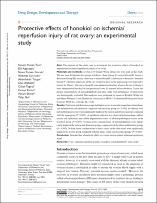Protective effects of honokiol on ischemia/reperfusion injury of rat ovary: an experimental study

View/
Access
info:eu-repo/semantics/openAccessAttribution-NonCommercial 3.0 Unported (CC BY-NC 3.0)https://creativecommons.org/licenses/by-nc/3.0/Date
2016Author
Yaman Tunç, SenemAğaçayak, Elif
Yaman Görük, Neval
İçen, Mehmet Sait
Turgut, Abdülkadir
Alabalık, Ulaş
Toğrul, Cihan
Ekinci, Cenap
Ekinci, Aysun
Gül, Talip
Metadata
Show full item recordCitation
Yaman Tunç, S., Ağaçayak, E., Yaman Görük, N., İçen, M. S., Turgut, A., Alabalık, U., Toğrul, C., Ekinci, C., Ekinci, A., Gül, T. (2016). Protective effects of honokiol on ischemia/reperfusion injury of rat ovary: an experimental study. Drug Design, Development and Therapy, 10, 1077-1083.Abstract
Aim: The purpose of this study was to investigate the protective effect of honokiol on experimental ischemia/reperfusion injury of rat ovary. Materials and methods: A total of 40 female Wistar albino rats were used in this study. The rats were divided into five groups as follows: sham (Group I), torsion (Group II), torsion + detorsion (Group III), torsion + detorsion + saline (Group IV), and torsion + detorsion + honokiol (Group V). Bilateral adnexa in all the rats except for those in the sham group were exposed to torsion for 3 hours. The rats in Group IV were administered saline, whereas the rats in Group V were administered honokiol by intraperitoneal route 30 minutes before detorsion. Tissue and plasma concentrations of malondialdehyde and nitric oxide were determined. Ovarian tissue was histologically evaluated. Data analyses were performed by means of Kruskal–Wallis test and Mann–Whitney U-test (Bonferroni correction) in SPSS 15.0 (Statistical Package for Social Sciences; SPSS Inc., Chicago, IL, USA). Results: The torsion and detorsion groups had higher scores in vascular congestion, hemorrhage, and inflammatory cell infiltration compared with the sham group (P<0.005). In addition, total histopathological scores were significantly higher in the torsion and detorsion groups compared with the sham group (P<0.005). A significant reduction was observed in hemorrhage, inflammatory cell infiltration, and cellular degeneration scores, of all histopathological scores, in the honokiol group (P<0.005). Ovarian tissue concentrations of malondialdehyde were significantly higher in the torsion and detorsion groups compared with the sham and honokiol groups (P<0.005). Ovarian tissue concentrations of nitric oxide, on the other hand, were significantly higher in the torsion group compared with the sham, saline, and honokiol groups (P<0.005). Conclusion: Honokiol has a beneficial effect on ovarian torsion-related ischemia/reperfusion injury. © 2016 Yaman Tunc et al.


















